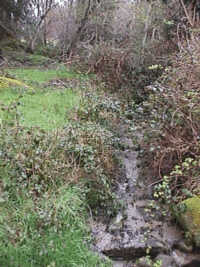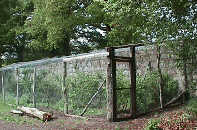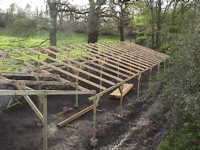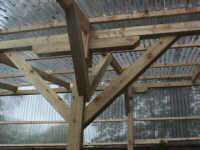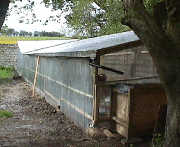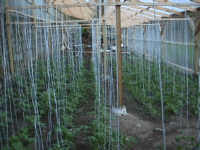| All About Organic | The Conversion Plan | Journal 2003 | Journal 2002 | Journal 2001 | Journal 2000 | Tricks and Tips | Links |
2002 Record
This year we have implemented some major changes. We have moved all vegetable production from the Cantry Bog to the Garden Field, expanded the cultivated area to approximately 2.7 hectares and changed the rotation from an eight plot (year) rotation to a six plot rotation.
We moved from the Cantry Bog because it became evident that drainage improvement would be unlikely to cope with the rainwater draining from neighbouring fields thus making cultivation more difficult than necessary. The soil has improved, however, and we intend to plant perennials in the Cantry Bog including trees, such as willow and poplar which can cope in the wetter parts of the Cantry Bog, and herbs.
We have moved cultivation to the higher part of the Garden Field which benefits from good light for most of the daylight hours (little shading), has generally good drainage and somewhat improved soil texture thanks to repeated tilling in 2001.
We have also begun indoor propagation of tomatoes. While these are grown from organic seed and to organic standards, the greenhouse is not on certified land.

The first 2 plantings (6 rows) of potatoes
sprouting in the Garden Field in early June 2002.
| Preparation January and February was used to mark out the plots for the new rotation in the Garden Field and till the soil several times. Each plot is tilled at least four times in the month prior to first planting to break up plant matter, aerate and generally improve soil condition. We have found that extra tilling early in the season helps with planting and weed control later on.
Tilling in February ... with santa's help! |
||||||||||||||||||||||||||||||||||||
| Notes Apparently weather this year is not good. Too cold for too long and too dry when moisture was needed, too wet for proper growth. Apparently conventional growers around Dublin where ploughing up fields of cabbage in June! Certainly we were penalised by dry weather just after transplanting the first batch of brassicas and the wettness in May retarded some crops. While we may take some comfort from the fact that generally yields are depressed around the country, our potential harvest is now less than half of what it might have been - fortunately we have a diversified production base. Pest attack was normal and generally under control. Crows and pigeons have been somewhat troublesome as usual. While they do get some of the ground pests eg slugs, crows attack the potatoes and pigeons the beans and brassicas. We seem to able to control this by stringing above the potatoes, fleecing brassicas and blasting a shotgun regularly. |
||||||||||||||||||||||||||||||||||||
| Plot 1 - Beans Week 3/25: Row 1(504 units) and 20m (70 units) of row 2 planted
with broad bean (super acquadulce). Seed spaciong approx 10 cm Row
spacing approx 2 m. Total 22 kg broad beans, few french. |
||||||||||||||||||||||||||||||||||||
| Plot 2 - Carrots Week 3/25: Two wide rows prepared with tractor tiller. Row 1 planted
double row with parsnip (half double with Tender and True, other
half double with Halflong Guernsey and T&T) for 100m then onion
for last 50m (275 units). Row 2 planted double row with parsnip
(half double T&T) and carrot, garlic chives and parsnip. |
||||||||||||||||||||||||||||||||||||
| Plot 3 - Courgette Week 4/22: Un-planted area tilled. Total 1.1kg |
||||||||||||||||||||||||||||||||||||
| Plot 4 - Peas Week 3/25: Row 1, 2 and a bit planted with markana peas. Seed spaciong
approx 10 cm Row spacing approx 1 m. Total 29 kg |
||||||||||||||||||||||||||||||||||||
| Plot 5 - Potatoes Week 3/25: Prepared three rows at top and three rows at bottom.
Row 1 planted record (100m, 360 units), row 2 with premier (350
units), row 3 with osprey (252 units). Total approx 140kg new and 100 kg old. Arran is good, cara, osprey
too. Record taste good but yield low. Premier taste OK but yield
unacceptable. |
||||||||||||||||||||||||||||||||||||
| Plot 6 - Brassicas and spinach Week 2/25: sowed brassicas and tomatoes in seed trays of organic
compost in greenhouse. |
||||||||||||||||||||||||||||||||||||
| Other The main other cultivated areas is the tomato plot in the greenhouse. This is not on certified land although we are growing to organic standards. The tomatoes were germinated in February and transplanted in early May. This was about 3 - 5 weeks too late but we had to finish the greenhouse first! Transplanting went very well with almost no losses. Since then the plants have been supported and an irrigation system has been installed (even watering with a hose pipe takes about an hour - fruiting tomatoes can take 1 litre a day per plant!). In June the plants were heavily pruned although not many shoots were cut. Fruit growth seems to be OK. By the end of July the tops need to be clipped or twined to stop growth at the top of the supports. We started adding a liquid organic feed to the watering reservoir in mid-July but still at a very low concentration (about 1% of instructed dilution). This seems to helpcompost leaves etc dropping into the reservoir and plant growth in encouraged. More liquid organic feed was added to the reservoir in September as production increased. In July we plucked the first tomatoes - quite juicy ... Tomato harvest:
Total harvest approximately 110 kg (may have lost 50kg + to fungus). Many tomatoes were lost from September due to fungus caused by planting too close and inadequate ventilation. Fungus susceptibility is raised in grey damp weather. We also planted a few beans, cabbages and potatoes in the Walled Garden to see how they would do. Mostly all are doing fine despite little attention and healthy weeds. Broad beans got aphid attack. The Cantry Bog was cleaned up. This involved about 2 days of digging up the chiocken wire circumference. Most of this was saved, some to be reused in the fruit cage, but some was in too poor condition and was disposed of. The glade and brook area between Cantry Bog and Garden Field was tidied with barbed wire removal and trimming of bushes. Its now even more accessible and pleasant.
We have continued cleaning up the walled garden so that now it is accessible. The beech hedge has been trimmed, the fruit cage relocated and a greenhouse built. The river banks are receiving more attention and we are beginning to get them under control. While we want to allow the jungle to continue to thrive the main access path is now more accessible and we can take a small tractor down much of the bank for mowing. |
||||||||||||||||||||||||||||||||||||
| Walled Garden In February we trimmed the "beech hedge". This comprises about 30 50m high beech trees that used to be a hedge until the 1940s/50s when it was allowed to grow. We cut selected trunk branches at about 2-3 m off the ground. Very dangerous work - almost executed by a splitting trunk despite precautions. But the end result is continued protection from wind, much more sunlight passing through and lots of low-end construction timber and firewood. Fruit cage Once the beech hedge was trimmed we were able to relocate the fruit cages along the south facing wall. Tom Townsend removed the raspberries, gooseberries, black currants and red currants in February when there is still very slow growth in them, and lined them up in their new location. Then in May, when the weather was finer, using timber from the beeches and reusing chicken wire from the Cantry Bog, he built a new cage. The main pillars were well dug in about 60 cm deep, the stone wall was used as the back wall and chicken wire was wired around the outside. Beech beams from pillar to wall can now be used to string up drooping bushes, because the beams are above the replanted fruit bushes.
The fruit cage built around the soft fruit bushes in May 2002. Greenhouse We finally bit the bullet and decided to build a greenhouse. This was built on a south facing wall with a stream running close by. Starting with some sketches and site observation Edi put together some drawings to guage size, angles and materials required. The next step was ground preparation, but because a contractor was not available immediately foundations were started. These comprise cement pillars moulded from used feed buckets set on large granite rocks. As this was nearing completion, the contractor arived and moved soil from old soft fruit beds (the soft fruits having been removed by Tom to a new location). The ground was built up around the foundations by approx 30cm and leveled. Timber was cut to size and the first pillars were installed against the wall. This involved drilling 10cm into the granite wall, plugging it with metal plastic padding, then forcing in 30cm of threaded bar. Pre-drilled timber, cut to length was then bolted on to the threaded bar.
The greenhouse frame nearly completed. A timber frame was then built up. Edi pre-cut all the timber to measurements calculated to give square angles where appropriate. A master carpenter. Check it out ...
Square corrugated sheeting was then nailed and screwed to the frame. We used the lowest cost durable covering available - a substitute for perspex which we bought under the brand Ondex. For doors, we started with a temporary set of doors discarded from a building site. The frame was used to make doors with the clear covering, and the timber boards previously used to skin the door now form the sides of a water reservoir.
Finished greenhouse with reservoir built The water reservoir is lined with damp proof membrane available at building materials suppliers. A submersible pump, powered via a 200m extension from the fuse box, feeds an irrigation system built from 34mm diameter plastic water supply pipe, drilled to accept 10 pierced hose pipes threading the floor of the green house. At the end of July we finally put a timer on the pump so watering is now entirely automatic (unless the reservoir runs dry - in which case it can be refilled from the stream in about 1 hour). Growing supports were easily installed by nailing bars at each pillared cross-section using Edi's premarked height record on the pillars, and then stringing baler twine lengthwise from which are supended strings for tying to the growing plants. So far its working well.
Crop support bars and baler twine supporting growing tomatoes. |
||||||||||||||||||||||||||||||||||||
| Maintenance Tractor: new front wheel bearing, replace windscreen with perspex, new uplink bars. 2 wheel tractor: new throttle and clutch cables. Checked brakes. New diff-lock lever. Topper: redesigned and rebuilt cutter bar allowing extra clearance. Welded frame with additional support on tractor side corner - seems to be working! May try to redesign cutter bar with chains instead of bar. Sickle bar mower: In renovation - new teeth required. |
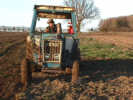 . . .
. . . 
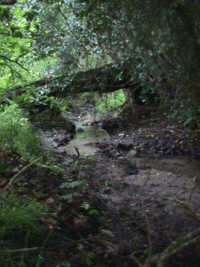 . . .
. . . 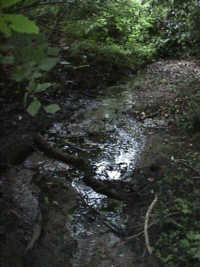 . . .
. . . 